Gobindgarh Fort Amritsar, Punjab
The fort occupied a unique place in the Indian military history. Built in 1760, it was called Bhangian Da Kila (Bhangis was one of the twelve Sikh misles). According to historians, during 1808, the fort was known as the fort of Gujjar Singh Bhangi. Later it was re-built by Maharaja Ranjit Singh with the help of Jodh Singh. The legendary Maharaja strengthened the fortification of the fort in order to keep his treasures and treaties in safety. The specially constructed Toshakhana, in the centre of the fort, also stored large amount of grains and provisions for the 12,000-strong army.
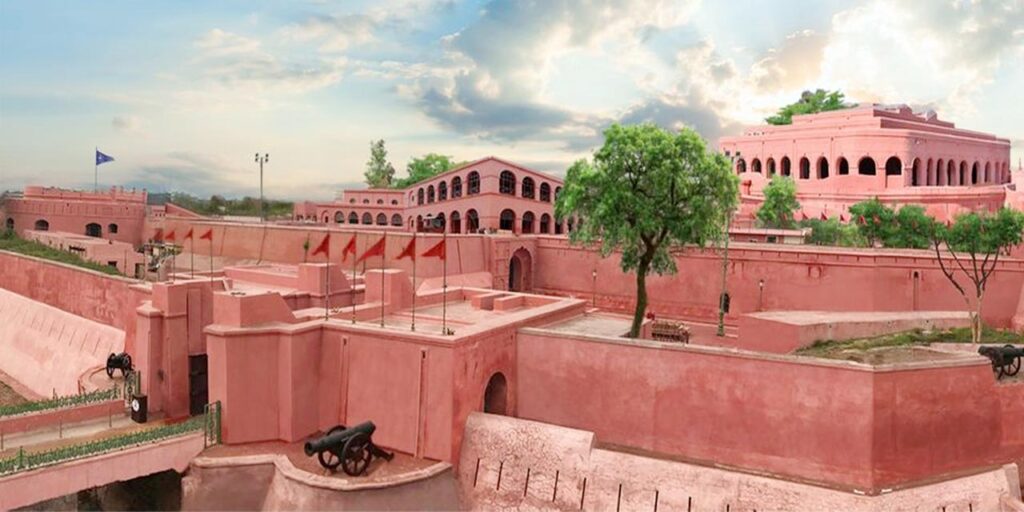
The fort was constructed with brick and lime with numerous army bastions and iron gates with 25 cannons on the ramparts, now replaced with modern weaponry. The fort was constructed on a square pattern with a parameter of 1500 sq mt with two strong gates, four large bastions and well-defined rampart. The majestic entrance has been named Nalwa Gate, after the great Sikh warrior. The other end of the gate is known as Keelar Gate and it is rumoured that in its close proximity existed an escape tunnel, connecting to Lahore tunnel. However, the army authorities said that they had not been able to locate any such tunnel so far.
The British Army had added Darbar Hall, Hawa Mehal and Phansi Ghar (hanging place) to the fort after the annexation of Punjab. After Partition, the fort provided a temporary shelter to a large number of refugees from Pakistan. In October 1948, the fort was handed over to the Indian Army.This fort holds a special significance in the freedom struggle. It has been a witness to many nameless freedom fighters who kissed the gallows willingly. Gen O Dyer’s office-cum-residence was located just opposite the Phansi Ghar. It is said that he got sadistic pleasure watching the hanging of the patriots in the Phansi Ghar.
Even the staunchest critics agree that the army had tried its best to keep the buildings in the fort intact. However, reservations are already being expressed whether the state government would be able to preserve (and restore) its original glory. A large number of city residents, who had lost their dear ones during summary trials under the British rule, have been trying to gather information about their relatives who were hanged to death in the Phansi Ghar.
Some of the freedom fighters had sought the permission of the government to build a suitable memorial at the Phansi Ghar, which had stood out as a place of resistance against the atrocities of the British military general, General O Dyer, the perpetrator of the massacre of Jallianwala Bagh in 1919. Fort Gobind Garh has been taken over by the Indian army and is now off limit.
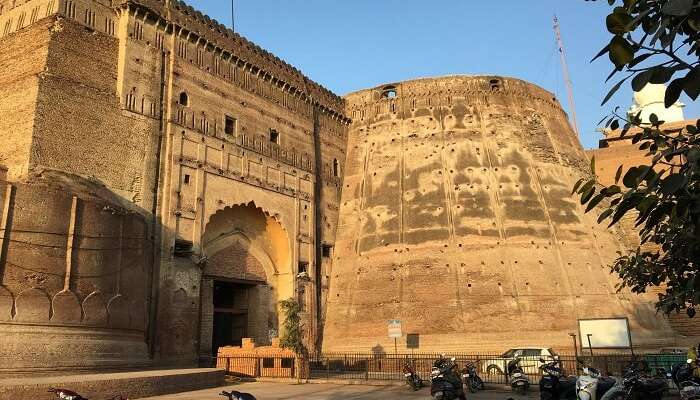
Bathinda Fort, Punjab
Schooner shaped fort stands like a ship in a sea of sand; design eminently suited to the desert environment; is reputed to be 1800 years old.
The Bathinda fort, which has stood since the period of Raja Deb (3rd century), one of the ancestors of Vinaipal is, an endangered structure now.
The first woman ruler (1236 AD) of India, Razia Sultan, was imprisoned in this fort. It was the capital of the kingdom of Jaipal (1004). Mahmud Ghazni captured the town and laid it waste by his loot, arson and plunder. Patiala ruler Maharaja Karam Singh (1813-1834) renamed it Gobindgarh in memory of the visit of Guru Gobind Singh’s to the fort.
A relic of Bathinda ‘s past splendour is the Bathinda fort and legend credits it’s building to king Binapaul. It is undisputable larger than its counterparts at Lahore, Bathinda fort is built on an area of 15 acres with height of its walls being approximately 150 feet during those days, its geographical and strategic situation made Bathinda the gateway to Rajasthan and Genetic plains; which is true even today. The fort is about 39 metres high and consists of 38 burjas
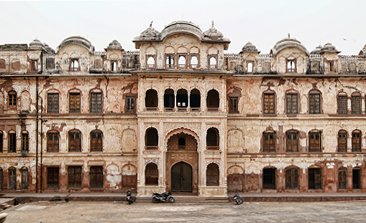
Faridkot Fort, Punjab
According to the compiler of the Gazetter of Faridkot State (Lahore, 1914), the old fort was built by Raja Mokulsi on square-shaped land, measuring more than 10 acres. Around 1775, it was reconstructed by Raja Hamir Singh. The main building seen at present and other important structures were built around 1890 by Raja Bikram Singh (1842-1898) and by Raja Balbir Singh (1869-1906).
Raja Bikram Singh, who ruled for 24 years, contributed a lot to Faridkot state. Raja Balbir Singh died in 1906 and was succeeded by Raja Barjinder Singh, who ruled up to 1918.The next and the last ruler of Faridkot state, Raja Sir Harinder Singh Brar Bans Bahadur, ascended the rajgaddi in 1918 after the death of Raja Barjinder Singh. On assuming power, he established many educational institutions and other important buildings in the town. The beauty of this fort lies in its magnificent architecture. Elegantly designed in European style and constructed by skilled masons, it is a masterpiece of workmanship. Its floors, ceilings, walls and arched openings have been executed with artistic precision.
Fashioned out of small Nanakshahi bricks and lime mortar, more than 20-foot-high ramparts and large bastions (burjs) constructed for the security guards and to mount the guns are still safe and sound, thanks to the repairs carried out by the Maharawal Khewa Ji Trust, Faridkot. But the main building and other structures of the complex (except Sheesh Mahal and Moti Mahal) need massive repairs and restoration work.
The entrance to the fort is provided through a beautiful multi-storeyed deori. It has a 14-foot-wide and 22-foot-high heavy wooden gate, which was used as a protective shield during war. The splendid artistic pattern on the ceiling of the deori is praiseworthy and attracts visitors. On the first floor of the deori is the beautifully designed Sheesh Mahal or hall of mirrors. The concave and convex glasswork is quite romantic. Some beautiful paintings decorate the walls. The desire of Raja Sir Harinder Singh to have a large museum in Sheesh Mahal is yet to be fulfilled. To make the fort impressive, two big guns placed in the baradari welcome visitors to the fort. The main building and other structures of the fort have been constructed on a ground which is 12 feet above the main road and entrance gate, for safety reasons.
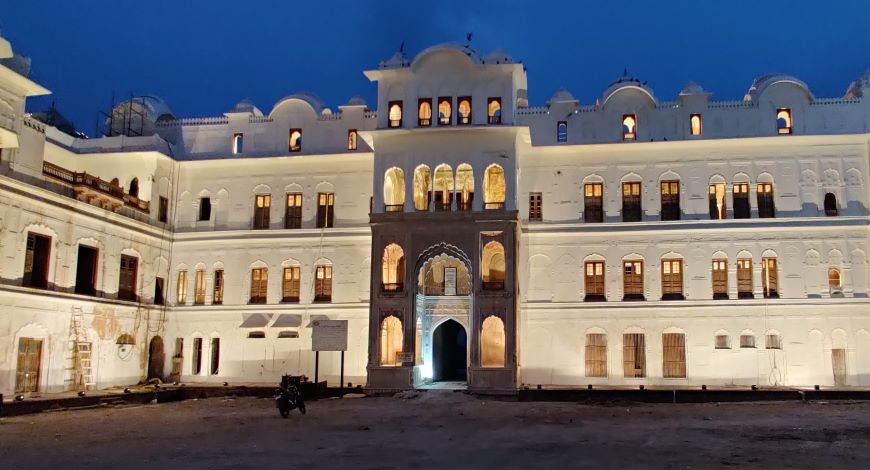
Quila Mubarak Patiala, Punjab
Patiala, a city of gardens and palaces, has a rich architectural and cultural heritage. The oldest part of Patiala is the walled city within which Quila Mubarak; the oldest fortified palace of the city, sits on a raised mound. Quila Mubarak forms the core around which the walled city developed. It dates back to 1763 AD.
Baba Ala Singh, who was the founder of the Patiala dynasty built a kachigarhi (mud fortress) and named it Quila Mubarak. Later, it was reconstructed in baked bricks. Maharaja Amar Singh (1765-1781 AD) completed the construction of the inner palace called the Quila Androon. Maharaja Sahib Singh (1781- 1813 AD), Maharaja Karam Singh (1813 AD – 1845 AD) Maharaja Narinder Singh (1845 AD to 1862) had also resided in this fort. The Quila is spatially preceded by the Quila Chowk and encircled by three major commercial spines, the Gur Mandi, Bajaja Bazaar and Shah Nashin Bazaar. The Adalat Bazaar starts from the Quila and terminates at the Anardana Chowk.
The Quila Mubarak Complex comprises numerous buildings, namely the Quila Androon, Ran Basa, Darbar Hall, Jalau Khana, Sard Khana, Quila Mubarak Gateway and the boundary walls. The Quila Mubarak Gateway is the only entrance to the Quila Mubarak Complex; it leads into a large public space called the Quila Androon Chowk. It is from this space that the monumental scale of Quila Androon can be experienced. The Quila Mubarak Gate is rendered in red sandstone and carries the appearance of a rather permeable latticed structure due to its multiple arched openings. On the inner edge of the Quila Androon Chowk is the Androon Gateway leading into Quila Androon. This is a solid masonry gateway with stuccowork.
Bahadurgarh Fort Patiala, Punjab
Bahadurgarh Fort 6 kms from Patiala originally founded by Nawab Saif Khan in 1658. Maharaja Karam Singh of Patiala built the present fort in 1837. It has two circular ramparts and is surrounded by a moat and covers an area of 2100 sq meters. This rather compact but nicely designed citadel is in the custody of the Department of police.
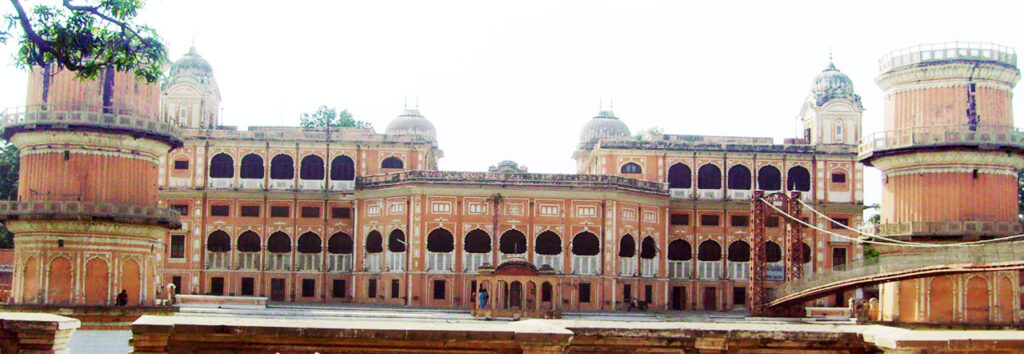
The four wails of the fort enclose the village Saifabad located on the left side of the Rajpura-Patiala Road. Saif Khan, a relative of the Mughal Emperor Aurangzeb, after holding several important offices, became a hermit and settled down here. After his death he was buried here. His tomb behind the fort, a structure of 177 x 177 ft. is in a state of neglect. Notwithstanding this, his followers still lit a lamp on the tomb every Thursday.
The two inscriptions in the fort testify that the village and the mosque were founded in 1668 during the reign of Aurangzeb. As the custom goes, Nawab Saif Khan was a great admirer of Guru Teg Bahadur. He invited him to use rainy season here. His trip is commemorated by two gurdwaras- One inside the fort and the other outside across the road. It is well known as Maharaja Karam Singh constructed Panj Bali Gurdwara. The Bahadurgarh Fort throughout 1837-45 at a cost of Rs. 10, 00,000
Anandpur Sahib Fort, Ropar
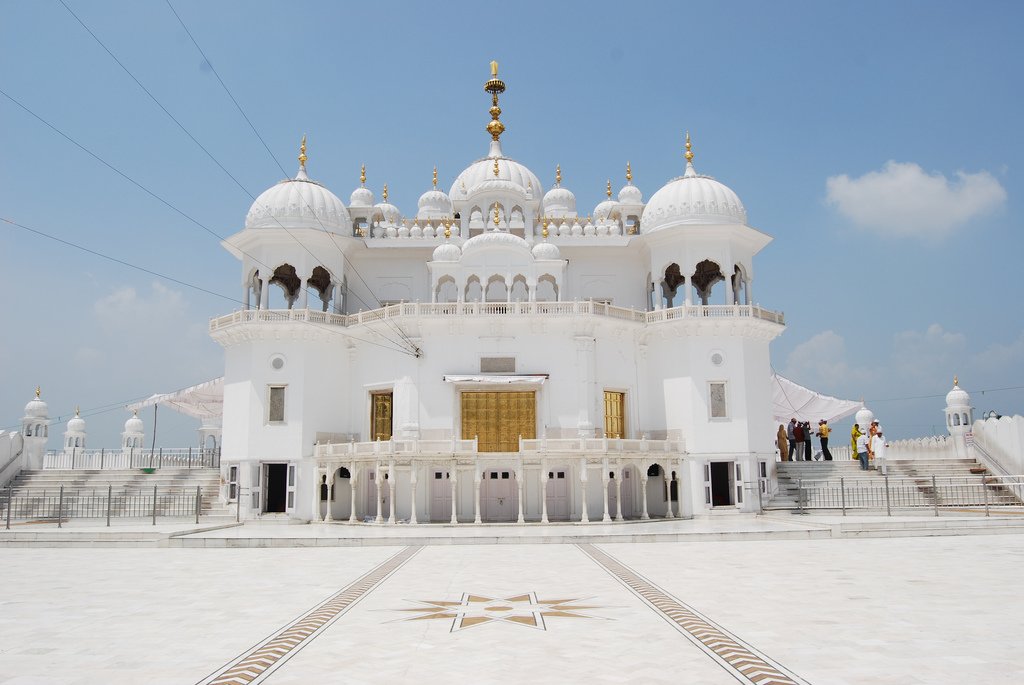
Anandpur Sahib Fort, Ropar. This was the first fort of Anandpur Sahib. Its foundation stone was laid on March 31, 1689. Guru Gobind Singh spent nearly 16 years in this fort, as it was strong and strategically located. The arms and ammunition of the Khalsa army were stored here. It was almost demolished by the army of Ajmer Chand in 1705.
Several years later, the Sikhs built a gurdwara at the site of Anandgarh fort. Later S Jassa Singh Ahluwalia built a baoli (step well) here. A few walls of the fort existed on the northern side until 1985, but were removed to make room for a new building. The other fort walls were destroyed to make way for a circular road.
Nevertheless, the gurdwara perched on a hill is an impressive sight. During the tri-centenary celebrations of the Khalsa Panth in 1999, a sound and light show depicting the history of the Sikhs in general and Anandpur Sahib in particular was held in this gurudwara every evening. This show commences each year during the Holla Mohalla and Baisakhi celebrations in March/April.
Phillaur Fort, Ludhiana
The Town of Phillaur in which this Fort is located owes its origin to a Sanghera Jat Phul called the town after him Phulnagar. Subsequently the Naru Rajputs under Rai Shahr whose territory extended from Mau to Selkiana occupied it & when his son Rai Rattan Pal abandoned Mau & settled at Phillaur.
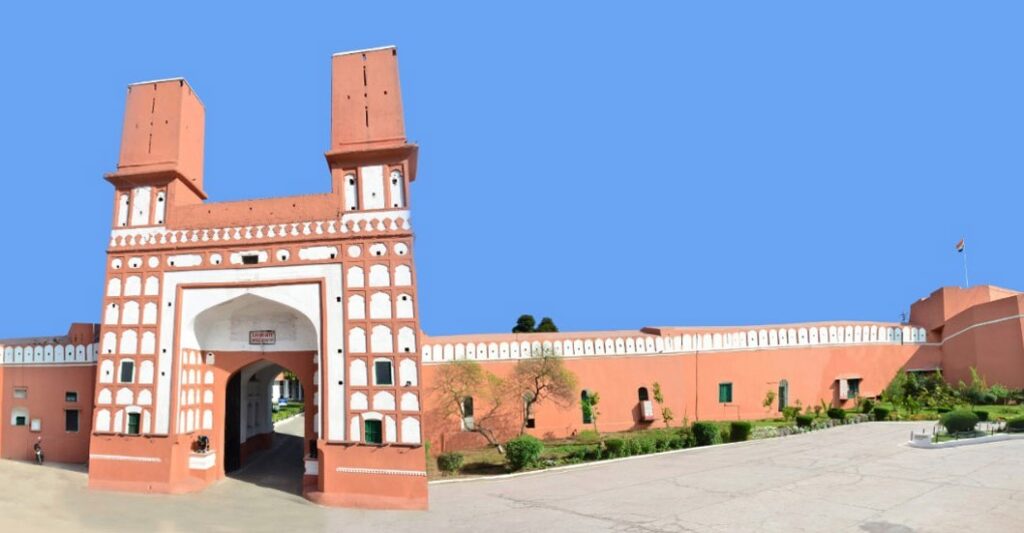
The Jats Left the modern town dates from the time of Shah Jahan (1627-1658 A.D.) when the sites covered with ruins reoccupied having been selected for the erection of a Serai on the imperial line of road from Delhi to Lahore, of its earlier history nothing of interest is recorded.
On the rise of the Sikhs to power, one Sudh Singh Kakara, who made it the capital of a considerable Estate, seized the place. His family became extinct in 1807 & the place then fell in to the hands of Maharaja Ranjit Singh who recognized its importance as a frontier town commanding the most frequented ferry of the Satluj. Under his governor Mohkam Chand a strong force was stationed at Phillaur from 1808 to 1812.
Shahpur Kandi Fort, Ludhiana
Shahpur Kandi Fort, 7 Km from Pathankot: This 16th century fort nestles at the foot of the towering Himalayas and overlooks the river Ravi, is a comfortable rest house now.
Bhao Singh, who named it after the Emperor Shah Jahan, built it in 16th century. The little town of Shahpur is located on the left bank of the Ravi River. The fort now functions as a rest house. Some Muslim Tombs and a mosque are sighted near the fort. There is a typical old stone tank just outside the village.
Palaces in Punjab

Summer Palace of Maharaja Ranjit Singh (1780-1838 AD), Amritsar
It was constructed under the supervision of Fakir Azeez-ud-din and Sardars Lehna Singh and Desa Singh Majithia, nobles of the Lahore Darbar at a cost of Nanak Shahi Rs. 1,25,000/- Originally, laid in a garden spreading across 84 acres of rare plants, trees and flowers, surrounded by a boundary wall, 14 feet high and a moat all around it, this beautiful palace had also several equally beautiful clusters of structure which were converted into clubs and libraries, the lawns around them into tennis courts by the British.
The entrance of the palace called the Darshani Deori is unique in design. It has four two storied towers in the cardinal directions. There are two tanks, the one connecting the palace with water channels fitted with fountains and the other with the air-conditioning pipes circuiting the outer walls and the bathing tanks of the double storied part of the residence. Some of the paintings and the mirror work on the roofs are still extant.
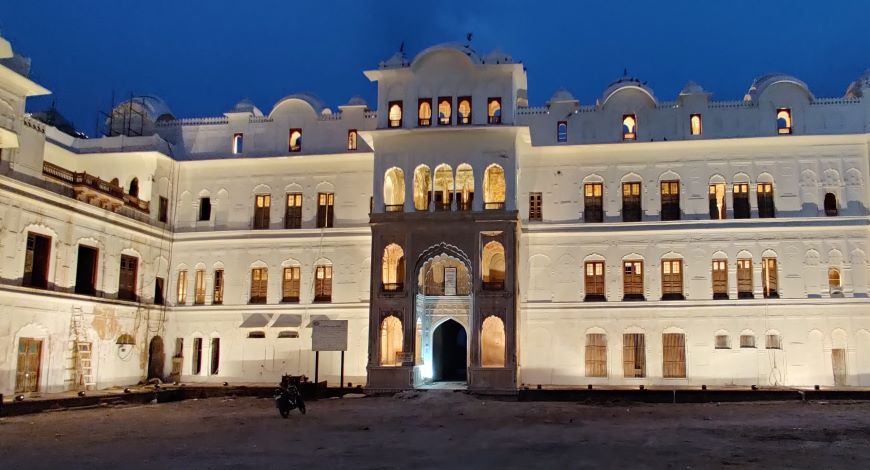
Qila Mubarak Patiala
The Qila (fort) was also the residence of Patiala dynasty. The residential part was called Qila Androon or the Inner Fort. Its living apartments have names like Jail Walla Palace for royal prisoners, the Moti (pearl) Palace, the Sheesh (mirror work) Palace, the Rajmata (Queen Mother) Palace, the Palace of Colours, and the Palace of the Moon. The recreational structures were called the Putli (Puppet) Ghar and Bagh Ghar or the Garden House. Its richly painted chambers are peerless.
Most astonishing of all, the Palace is fitted with underground sewerage system and has a cool room connected with a tunnel, which brings cool air from the basement. Lassi Khana-the royal kitchen used to feed 35,000 people of all ranks everyday.
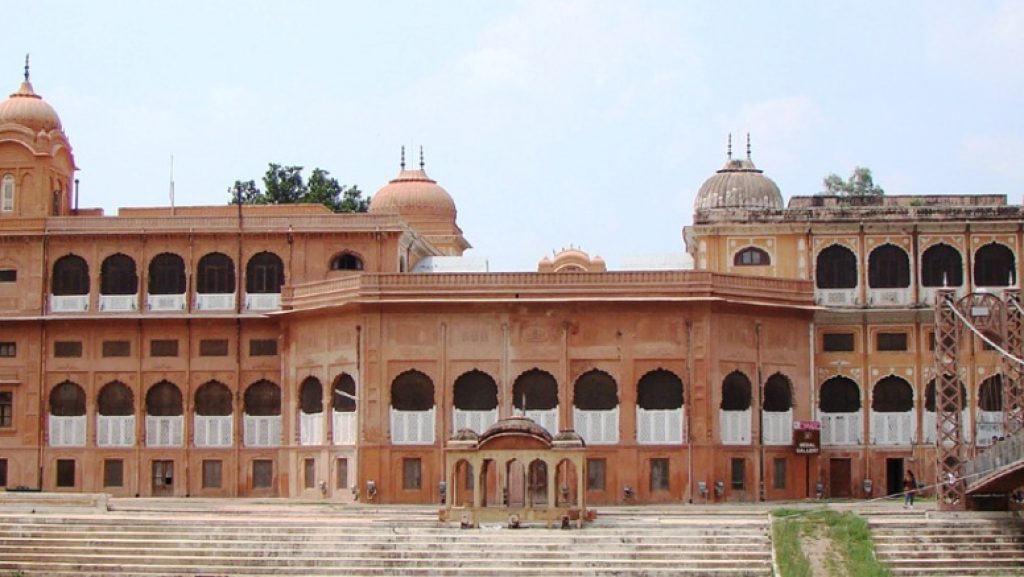
The Sheesh Mahal, Patiala
It was built in the reign of Maharaja Narinder Singh (1845-1862) in a forest with terraces, gardens, fountains and an artificial lake. With two watching towers in the north and the south the lake is connected to Banasar Ghar, where all type of stuffed animals are kept and Sheesh Mahal, the residential palace with a suspension bridge which is a copy of the Lakhsman Jhula at Rishikesh.
Part of the three-storied building is inset with pieces of reflecting mirrors and a large number of wall paintings depicting scenes from Bhagwat Puran and portraits of the Sikh Gurus. The palace has galleries displaying antique paintings, bronzes, sculptures and portraits of the Maharajas of Patiala. The highlight is the gallery, which displays the world’s largest collection of medals, decoration and orders of various countries.
The best and most impressive Palace in the Punjab was that of the ex-Ruler of Kapurthala, which has now been converted into a Sainik School. The palaces of Nabha and Faridkot are not open to public.
